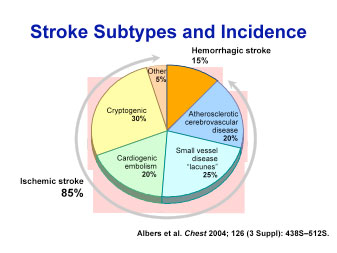Disorders and Treatments
A stroke occurs when the normal functioning of a part of the brain is affected because of a disturbance in its blood supply. An ischemic stroke is one when the blood supply is critically diminished resulting in either a transient ischemic attack or a more long lasting neurological deficit due to an infarction in the brain. A hemorrhagic stroke is the result of bleeding in the brain. Stroke is common, and it is estimated that 750,000 new strokes occur annually in the in the U.S. and also is the third leading cause of death.
Common risk factors of Stroke:

- Hypertension
- Diabetes
- Smoking
- Hypercholesterolemia
- Old age
- Cardiac Disease
- Obesity
Treatment of Stroke:
The good news is that ischemic stroke is now treatable provided the patient can be evaluated as soon as possible after the onset of stroke. Intravenous tissue plaminogen activator (tPA) is a FDA approved drug for carefully selected patients with acute ischemic stroke. Rapid advances are being made in application of thrombolytic therapy which can be delivered intra arterially to open occluded arteries. Endovascular approaches are being used to mechanically remove clots responsible for the stroke and open narrowed arteries using stents.
Exciting and effective as the acute treatment of ischemic stroke is, it is the old adage that comes to mind that an ounce of prevention is worth more a pound of cure! Primary and Secondary prevention measures include control of hypertension, diabetes, obesity, hyperlipidemia and smoking cessation. A large number of strokes can be effectively prevented with programs which address these factors. Antiplatelet and statin medications are now routinely used for stroke prophylaxis. Anticoagulation strategies are used to prevent certain types of cardioembolic strokes such as those resulting from atrial fibrillation. Surgery and endovascular treatments such as stenting can be applied to prevent strokes resulting from internal carotid artery stenosis and intracranial arterial stenosis.
The Comprehensive Stroke Center at our facility has a distinguished array of staff who are adept and are the cutting edge of developments in all these fields.
